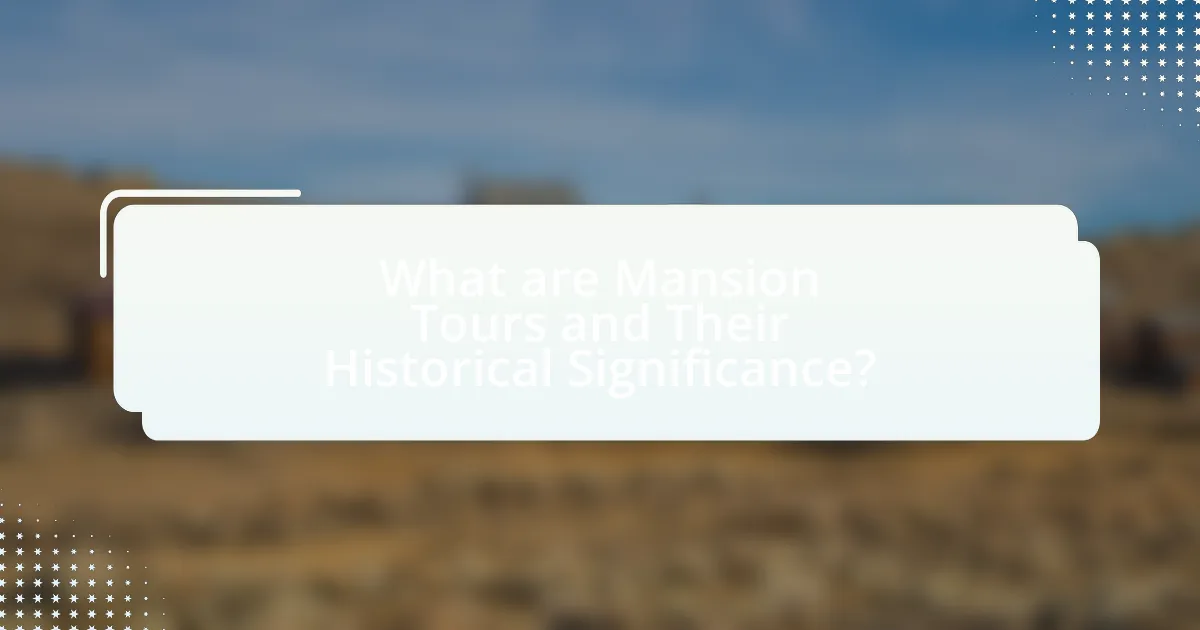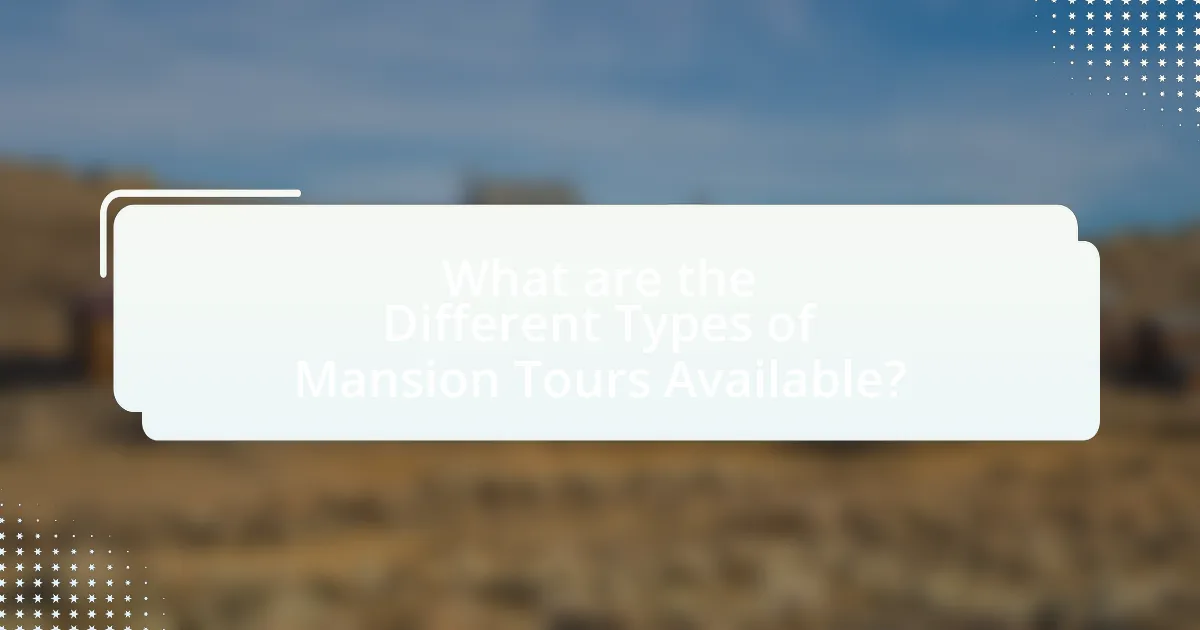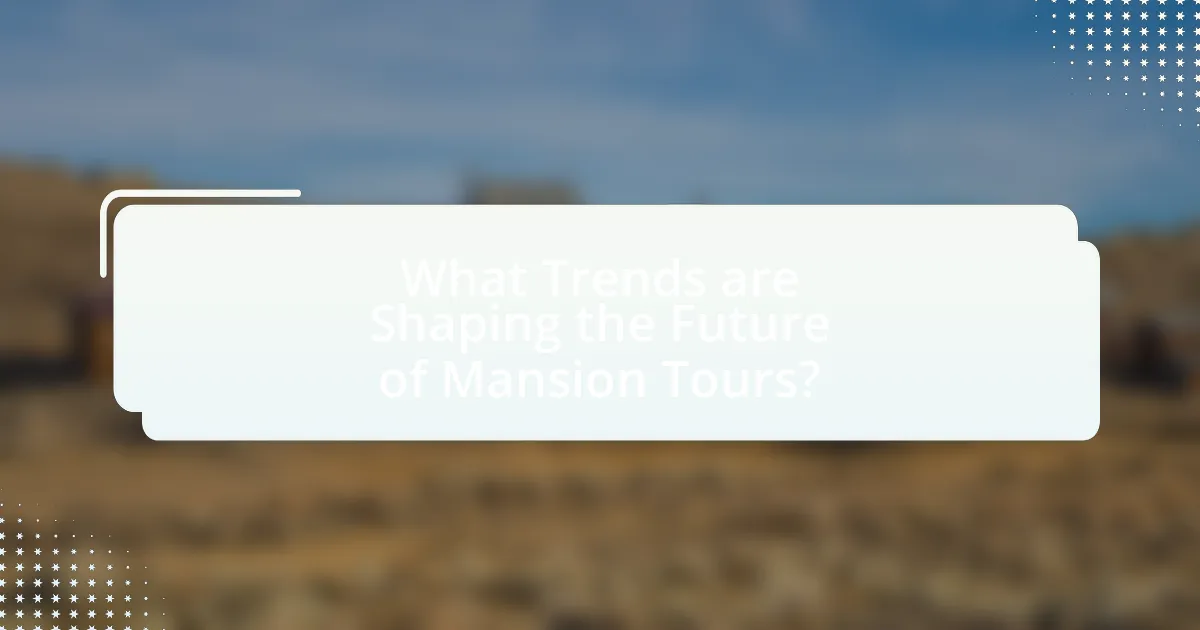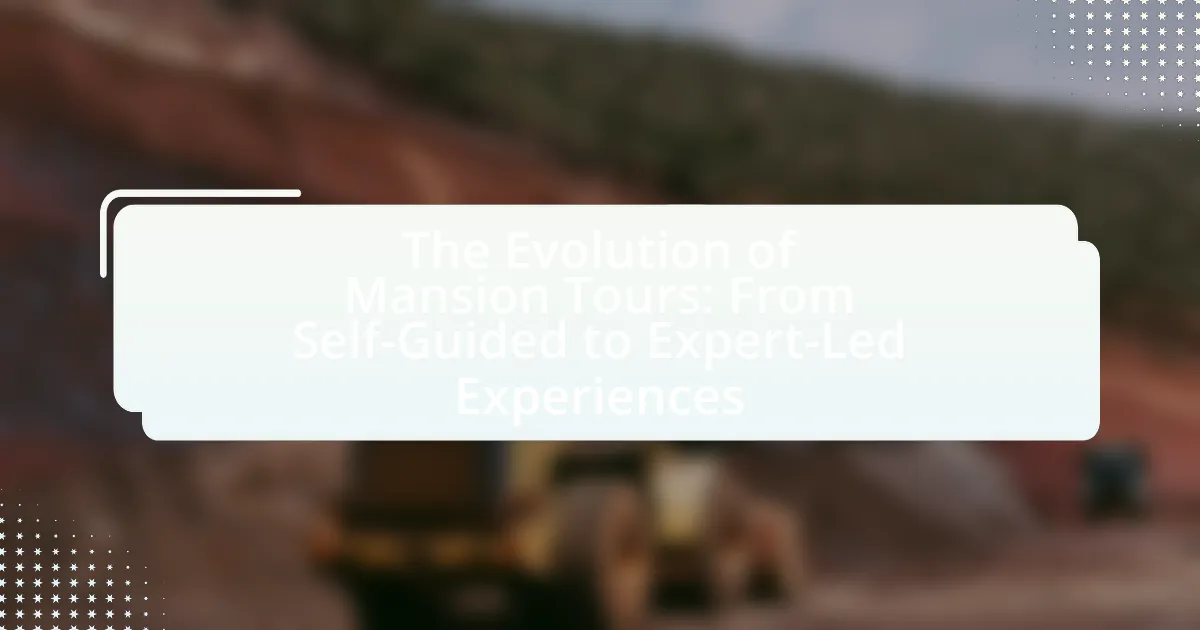Mansion tours, which encompass guided and self-guided visits to historically significant large residences, play a crucial role in showcasing architectural features and the lives of former inhabitants. The evolution of these tours has transitioned from self-guided experiences to expert-led formats that provide in-depth historical context and personalized insights. This article explores the historical significance of mansion tours, their evolution over time, the impact of societal changes, and their role in cultural heritage and local economies. Additionally, it examines the various types of tours available, the influence of technology, and emerging trends shaping the future of mansion tours.

What are Mansion Tours and Their Historical Significance?
Mansion tours are guided or self-guided visits to historically significant large residences, showcasing their architectural features, furnishings, and the lives of their former inhabitants. These tours often highlight the cultural and social history of the time periods in which the mansions were built, providing insights into the lifestyles of the wealthy elite. For example, the Biltmore Estate in North Carolina, built in the late 19th century, offers tours that reveal the Gilded Age’s opulence and the estate’s role in American history. Such tours serve to educate the public about historical events, architectural styles, and the evolution of social norms, making them vital for preserving cultural heritage.
How have mansion tours evolved over time?
Mansion tours have evolved from primarily self-guided experiences to expert-led tours that offer in-depth historical context and personalized insights. Initially, visitors explored mansions at their own pace, relying on printed materials or audio guides for information. Over time, the introduction of trained guides has enhanced the educational aspect of tours, allowing for interactive experiences that engage visitors more deeply. For example, many historic mansions now incorporate multimedia elements and themed tours that highlight specific aspects of architecture or the lives of former residents, reflecting a shift towards immersive storytelling. This evolution has been driven by a growing demand for enriched cultural experiences and a desire for deeper connections to history.
What were the earliest forms of mansion tours?
The earliest forms of mansion tours were primarily self-guided visits, where individuals explored the properties at their own pace. These tours often involved printed guides or pamphlets that provided basic information about the mansion’s history and architecture. Historical records indicate that in the 19th century, as public interest in grand estates grew, many owners began to open their homes to visitors, allowing them to experience the opulence and design of the era firsthand. This practice laid the groundwork for more structured tours that would develop later, as the demand for guided experiences increased.
How did societal changes influence the evolution of mansion tours?
Societal changes significantly influenced the evolution of mansion tours by shifting public interest from private ownership to shared cultural heritage. As the middle class expanded in the late 19th and early 20th centuries, there was a growing demand for accessible cultural experiences, leading to the transformation of private mansions into public attractions. This transition was marked by the establishment of guided tours, which provided educational context and historical narratives, catering to an audience eager to learn about the lifestyles of the elite. The rise of preservation movements in the mid-20th century further emphasized the importance of maintaining these properties as historical sites, resulting in more structured and expert-led tours that highlighted architectural significance and social history.
What role do mansion tours play in cultural heritage?
Mansion tours serve as vital conduits for cultural heritage by preserving and showcasing historical architecture, art, and the lifestyles of past inhabitants. These tours provide educational experiences that connect visitors to the historical significance of the properties, often highlighting unique architectural styles and cultural narratives that reflect the era in which they were built. For instance, many mansion tours include detailed explanations of the social and economic contexts that influenced their design and use, thereby enriching the understanding of local history and heritage. Additionally, mansion tours often contribute to the conservation of these properties, ensuring that they remain accessible for future generations to appreciate and learn from.
Why are mansion tours important for historical preservation?
Mansion tours are important for historical preservation because they provide educational experiences that foster public awareness and appreciation of architectural heritage. By engaging visitors with the history and significance of these properties, tours encourage community support for preservation efforts. For instance, the National Trust for Historic Preservation reports that heritage tourism, which includes mansion tours, contributes significantly to local economies and promotes the conservation of historic sites. This economic incentive reinforces the value of maintaining these structures for future generations.
How do mansion tours contribute to local economies?
Mansion tours contribute to local economies by generating revenue through tourism, which supports local businesses and creates jobs. For instance, visitors to mansion tours often spend money on nearby restaurants, hotels, and shops, leading to an increase in local sales tax revenue. According to the National Trust for Historic Preservation, heritage tourism, which includes mansion tours, can significantly boost local economies, with some areas reporting increases in tourism-related income by up to 30%. Additionally, mansion tours often require staff for operations, thus creating employment opportunities in the community.

What are the Different Types of Mansion Tours Available?
Different types of mansion tours available include self-guided tours, guided tours, audio tours, and specialty tours. Self-guided tours allow visitors to explore at their own pace, often using brochures or mobile apps for information. Guided tours are led by knowledgeable guides who provide detailed insights and historical context. Audio tours offer recorded commentary that visitors can listen to while walking through the mansion. Specialty tours may focus on specific themes, such as architecture, art, or historical events, providing a deeper understanding of particular aspects of the mansion. Each type caters to different preferences and enhances the visitor experience in unique ways.
What distinguishes self-guided tours from expert-led experiences?
Self-guided tours allow individuals to explore at their own pace without the presence of a guide, while expert-led experiences provide structured insights and knowledge from a knowledgeable guide. Self-guided tours typically rely on maps, brochures, or audio guides, enabling visitors to choose their own route and timing, which fosters independence. In contrast, expert-led experiences offer curated narratives and context, often enhancing the understanding of historical significance and architectural details, as evidenced by studies showing that guided tours can increase visitor engagement and retention of information.
What are the advantages of self-guided mansion tours?
Self-guided mansion tours offer flexibility and personalization, allowing visitors to explore at their own pace and focus on areas of interest. This autonomy enhances the experience, as individuals can spend more time on exhibits that captivate them without the constraints of a scheduled group tour. Additionally, self-guided tours often utilize technology, such as mobile apps or audio guides, which can provide rich historical context and detailed information, making the experience both informative and engaging. Studies indicate that visitors retain more information when they engage with content at their own pace, further validating the effectiveness of self-guided formats.
How do expert-led tours enhance the visitor experience?
Expert-led tours enhance the visitor experience by providing in-depth knowledge and context that self-guided tours often lack. These tours allow visitors to engage with experts who can share unique insights, historical anecdotes, and specialized information about the mansion’s architecture, art, and history. For instance, a study by the National Trust for Historic Preservation found that guided tours significantly increase visitor satisfaction and retention of information compared to self-guided experiences. This interaction fosters a deeper appreciation and understanding of the site, making the visit more memorable and enriching.
What unique features do themed mansion tours offer?
Themed mansion tours offer immersive experiences that combine historical context with engaging narratives tailored to specific themes, such as architecture, art, or notable residents. These tours often include interactive elements, such as guided storytelling, period costumes, and themed events that enhance visitor engagement. For instance, a tour focused on the Gilded Age may feature actors portraying historical figures, providing a dynamic understanding of the era. Additionally, themed tours frequently utilize multimedia presentations, such as audio guides or augmented reality, to enrich the visitor experience and provide deeper insights into the mansion’s history and significance.
How do seasonal tours differ from regular tours?
Seasonal tours differ from regular tours primarily in their timing and thematic focus, as seasonal tours are designed to coincide with specific times of the year, such as holidays or seasonal events, while regular tours operate year-round without such constraints. For example, a mansion may offer a special holiday-themed tour in December that highlights festive decorations and seasonal history, whereas a regular tour would provide a general overview of the mansion’s architecture and history at any time of the year. This distinction allows seasonal tours to create unique experiences that cater to the interests and expectations of visitors during particular seasons, enhancing engagement and relevance.
What are the benefits of interactive mansion tours?
Interactive mansion tours enhance visitor engagement and learning by allowing participants to actively explore and interact with the environment. These tours often incorporate technology, such as augmented reality or mobile applications, which provide immersive experiences and detailed historical context. For instance, studies show that interactive elements can increase retention of information by up to 60%, compared to traditional guided tours. Additionally, interactive tours cater to diverse learning styles, making the experience more inclusive and enjoyable for a wider audience.

What Trends are Shaping the Future of Mansion Tours?
Virtual reality and augmented reality are key trends shaping the future of mansion tours. These technologies enhance visitor experiences by allowing immersive exploration of historical properties, enabling users to visualize the mansion’s original state and interact with its features. According to a 2022 report by the National Trust for Historic Preservation, 70% of surveyed historic sites indicated plans to incorporate digital technologies to engage younger audiences. Additionally, personalized tours using AI-driven apps are gaining popularity, offering tailored experiences based on visitor preferences, which can increase visitor satisfaction and engagement.
How is technology influencing mansion tour experiences?
Technology is significantly enhancing mansion tour experiences by integrating virtual reality, augmented reality, and mobile applications. These advancements allow visitors to engage with the historical context and architectural details of the mansions in immersive ways. For instance, virtual reality can transport users to different time periods, providing a richer understanding of the mansion’s history. Augmented reality applications can overlay information and multimedia content onto physical spaces, enriching the visitor’s experience with interactive elements. Additionally, mobile apps facilitate self-guided tours, enabling guests to explore at their own pace while accessing detailed information and multimedia content about the mansion’s features. This technological integration not only improves visitor engagement but also increases accessibility and educational value, making mansion tours more informative and enjoyable.
What role do virtual tours play in the mansion tour landscape?
Virtual tours serve as a transformative tool in the mansion tour landscape by providing accessible, immersive experiences that attract a broader audience. They allow potential visitors to explore historical estates and architectural marvels from the comfort of their homes, thereby increasing engagement and interest in physical tours. According to a study by the National Trust for Historic Preservation, virtual tours can enhance visitor numbers by up to 30% when combined with in-person experiences, demonstrating their effectiveness in expanding reach and accessibility.
How are mobile apps enhancing visitor engagement during tours?
Mobile apps are enhancing visitor engagement during tours by providing interactive content, real-time information, and personalized experiences. These applications allow visitors to access multimedia elements such as videos, audio guides, and augmented reality features that enrich the tour experience. For instance, a study by the University of Southern California found that 70% of visitors reported increased satisfaction when using mobile apps that offered interactive maps and detailed historical context. Additionally, mobile apps enable visitors to customize their tour routes based on personal interests, leading to a more engaging and tailored experience.
What are the emerging preferences of modern tourists regarding mansion tours?
Modern tourists increasingly prefer immersive and interactive experiences during mansion tours, favoring guided tours led by knowledgeable experts over self-guided options. This shift is driven by a desire for deeper engagement with the history and architecture of the mansions, as well as personalized storytelling that enhances their understanding of the cultural significance of these properties. Research indicates that 70% of travelers value expert-led tours for the enriched context they provide, making them more appealing than traditional self-guided formats.
How do sustainability practices impact mansion tours?
Sustainability practices significantly enhance mansion tours by promoting eco-friendly initiatives that attract environmentally conscious visitors. Implementing energy-efficient systems, utilizing sustainable materials, and preserving natural landscapes not only reduce the carbon footprint of these historic properties but also create a unique selling point for tours. For instance, a study by the National Trust for Historic Preservation found that properties emphasizing sustainability saw a 20% increase in visitor engagement, demonstrating that eco-friendly practices resonate with modern audiences.
What are the expectations of tourists for personalized experiences?
Tourists expect personalized experiences that cater to their individual preferences and interests. This includes tailored itineraries, unique local insights, and opportunities for interaction with local culture. Research indicates that 70% of travelers are more likely to book a trip if they know they will receive personalized recommendations, highlighting the demand for customized experiences in tourism.
What Tips Can Enhance Your Mansion Tour Experience?
To enhance your mansion tour experience, consider engaging with a knowledgeable guide who can provide historical context and interesting anecdotes about the property. Expert-led tours often reveal details that self-guided tours may overlook, such as architectural significance and the lives of past residents. Additionally, taking notes or using a mobile app to capture highlights can help retain information for later reflection. Researching the mansion’s history beforehand can also enrich your understanding and appreciation during the tour. Studies show that guided tours increase visitor satisfaction by 30% compared to self-guided experiences, emphasizing the value of expert insights.
How can you prepare for a mansion tour to maximize enjoyment?
To maximize enjoyment during a mansion tour, research the mansion’s history and architecture beforehand. Understanding the background enhances appreciation of the details and significance of the property. For instance, knowing that the mansion was built in the early 1900s and features specific architectural styles, such as Beaux-Arts or Victorian, allows for a deeper connection to the space. Additionally, reviewing any available tour materials or guides can provide insights into key areas of interest, ensuring that visitors can engage meaningfully with the tour content.
What should you look for when choosing between self-guided and expert-led tours?
When choosing between self-guided and expert-led tours, consider the level of information and engagement you desire. Self-guided tours offer flexibility and independence, allowing you to explore at your own pace, while expert-led tours provide in-depth knowledge and context from a knowledgeable guide. Research indicates that participants in expert-led tours often report higher satisfaction due to the enriched experience and insights provided by the guide, which can enhance understanding of historical and cultural significance.

Leave a Reply